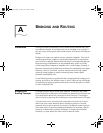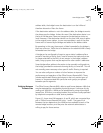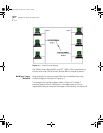
IP Routing
A-9
Once the packet is received by the Router A, attached to LAN 1, it strips
off the network header (refer to Figure above) and examines the Layer 3
header information. It then reviews its routing tables in order to establish
where to forward the data packet. It is possible that the LAN 1 router has
multiple outgoing ports that would allow different transmission routes to
the destination network. In our example using Figure A-3, a packet could
go via Router D to get to Router B, or it could go more directly across a
single direct link between Router A and Router B.
Figure A–5 Data Packet Containing Hardware and Software Addresses
IP Routing
The local router contains, within its routing table, information that will
allow it to determine the best data transmission route. The type of
information the router uses to make these assessments is
protocol-dependent, and some communications protocols may employ a
range of routing algorithms, and accompanying routing protocols. In the
case of the TCP/IP protocol suite, the OfficeConnect Remote 840 utilizes
RIP. RIP is also known as a distance vector protocol.
Different protocols use different networking characteristics or metrics
when making routing decisions. The metric employed by RIP is a hop
count. A hop count is defined by the number of routing nodes there are
between the source and destination units. In our example, there are two
hops between LAN 1 and LAN 2 going via Routers A and B. If traffic was
directed via Routers A,D, and then B, this would be three hops.
840ug.book Page 9 Friday, July 7, 2000 2:23 PM


















